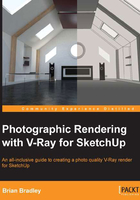
Summary
Let's summarize the elements of photographic rendering that we have very quickly touched in this chapter.
As with any construction project, the crafting of a photographic render requires that we start with a solid foundation. In this instance, that means getting our basic composition in the scene right before we move on to using the tools found in the render engine itself. Solid compositional principles such as thirds, leading lines, and points of view should be considered and possibly even tried out at this phase of the project.
Once we have that in place, we can then move onto using V-Ray tools to craft a lighting setup in the scene that creates an appropriate mood for us; then, build and apply materials to scene geometry that have believable physical properties associated with them.
Add to this mix global illumination, exposure control, and then finally our finished render and output quality control settings. Now, we have a recipe for successfully creating photographic renders with V-Ray.
Of course, in this introductory chapter, we have moved incredibly quickly through the basic process of rendering an image in V-Ray. What we need to do now is break down the key processes and tools in a little more depth so that we can fully understand both the power of the tools available as well as learn how to control them. Next up is lighting; specifically, a look at how we can go about lighting an interior daytime scene from the ground up.